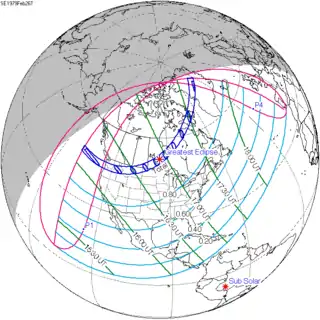| Partial eclipse | |||||||||||||
| Date | 21 February 1970 | ||||||||||||
|---|---|---|---|---|---|---|---|---|---|---|---|---|---|
| Gamma | 0.96198 | ||||||||||||
| Magnitude | 0.04639 | ||||||||||||
| Saros cycle | 113 (61 of 71) | ||||||||||||
| Partiality | 52 minutes, 42.4 seconds | ||||||||||||
| Penumbral | 298 minutes, 37.5 seconds | ||||||||||||
| |||||||||||||
A partial lunar eclipse took place on Saturday, February 21, 1970. It was the first of two partial lunar eclipses in 1970, the other being on August 17 of the same year. A tiny bite out of the Moon may have been visible at maximum, though just 5% of the Moon was shadowed in a partial eclipse which lasted for 52 minutes and 42 seconds. A shading across the moon from the Earth's penumbral shadow should have been visible at maximum eclipse.
Occurring only 2.4 days after apogee (Apogee on Wednesday, February 18, 1970), the Moon's apparent diameter was 6% smaller than average. The Moon was only 404,163 km (251,135 mi) from the Earth's center.[1]
Visibility
It was completely visible over eastern Asia, Australia, Pacific, Americas, western Europe, seen rising over northwestern Pacific Ocean and setting over the north Atlantic Ocean.

Relation to other lunar eclipses
Lunar year series
| Lunar eclipse series sets from 1969–1973 | ||||||||
|---|---|---|---|---|---|---|---|---|
| Ascending node | Descending node | |||||||
| Saros | Date Viewing |
Type Chart |
Gamma | Saros | Date Viewing |
Type Chart |
Gamma | |
| 108 | 1969 Aug 27 |
Penumbral |
−1.54066 | 113 | 1970 Feb 21 |
Partial |
0.96198 | |
| 118 | 1970 Aug 17 |
Partial |
−0.80534 | 123 | 1971 Feb 10 |
Total |
0.27413 | |
| 128 | 1971 Aug 6 |
Total |
−0.07944 | 133 | 1972 Jan 30 |
Total |
−0.42729 | |
| 138 | 1972 Jul 26 |
Partial |
0.71167 | 143 | 1973 Jan 18 |
Penumbral |
−1.08446 | |
| 148 | 1973 Jul 15 |
Penumbral |
1.51782 | |||||
| Last set | 1969 Sep 25 | Last set | 1969 Apr 2 | |||||
| Next set | 1973 Jun 15 | Next set | 1973 Dec 10 | |||||
Metonic cycle
This is the third of five Metonic lunar eclipses.
The Metonic cycle repeats nearly exactly every 19 years and represents a Saros cycle plus one lunar year. Because it occurs on the same calendar date, the Earth's shadow will in nearly the same location relative to the background stars.
| Descending node | Ascending node | |||||
|---|---|---|---|---|---|---|
| Saros | Date | Type | Saros | Date | Type | |
| 103 | 1951 Feb 21.88 | Penumbral | 108 | 1951 Aug 17.13 | Penumbral | |
 |
 | |||||
| 113 | 1970 Feb 21.35 | Partial | 118 | 1970 Aug 17.14 | Partial | |
 |
 | |||||
| 123 | 1989 Feb 20.64 | Total | 128 | 1989 Aug 17.13 | Total | |
 |
 | |||||
| 133 | 2008 Feb 21.14 | Total | 138 | 2008 Aug 16.88 | Partial | |
 |
 | |||||
| 143 | 2027 Feb 20.96 | Penumbral | 148 | 2027 Aug 17.30 | Penumbral | |
 |
 | |||||
Half-Saros cycle
A lunar eclipse will be preceded and followed by solar eclipses by 9 years and 5.5 days (a half saros).[2] This lunar eclipse is related to two total solar eclipses of Solar Saros 120.
| February 15, 1961 | February 26, 1979 |
|---|---|
 |
 |
See also
Notes
- ↑ Saros series 113
- ↑ Mathematical Astronomy Morsels, Jean Meeus, p.110, Chapter 18, The half-saros
External links
- 1970 Feb 21 chart Eclipse Predictions by Fred Espenak, NASA/GSFC

_(cropped).jpg.webp)
